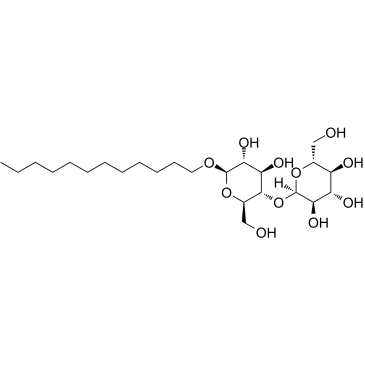n-Dodecyl-beta-D-maltoside

n-Dodecyl-beta-D-maltoside structure
|
Common Name | n-Dodecyl-beta-D-maltoside | ||
|---|---|---|---|---|
| CAS Number | 69227-93-6 | Molecular Weight | 510.615 | |
| Density | 1.3±0.1 g/cm3 | Boiling Point | 703.5±60.0 °C at 760 mmHg | |
| Molecular Formula | C24H46O11 | Melting Point | 224-226 °C(lit.) | |
| MSDS | USA | Flash Point | 379.3±32.9 °C | |
|
Mutational analyses of YqjA, a Tvp38/DedA protein of E. coli.
FEBS Lett. 589(7) , 842-8, (2015) Membrane proteins of the DedA/Tvp38 protein family are involved in membrane integrity and virulence of pathogenic organisms. However, the structure and exact function of any member of this large protein family are still unclear. In the present study we analyz... |
|
|
Mapping the Interactions between the NS4B and NS3 proteins of dengue virus.
J. Virol. 89(7) , 3471-83, (2015) Flavivirus RNA synthesis is mediated by a multiprotein complex associated with the endoplasmic reticulum membrane, named the replication complex (RC). Within the flavivirus RC, NS4B, an integral membrane protein with a role in virulence and regulation of the ... |
|
|
Co-expression of human agouti-related protein enhances expression and stability of human melanocortin-4 receptor.
Biochem. Biophys. Res. Commun. 456(1) , 116-21, (2014) G protein-coupled receptors (GPCRs) represent the largest family of transmembrane signaling proteins, and they are considered major targets of approximately half of all therapeutic agents. Human melanocortin-4 receptor (hMC4R) plays an important role in the c... |
|
|
Frontal cortex and hippocampus neurotransmitter receptor complex level parallels spatial memory performance in the radial arm maze.
Behav. Brain Res. 289 , 157-68, (2015) Several neurotransmitter receptors have been proposed to be involved in memory formation. However, information on receptor complexes (RCs) in the radial arm maze (RAM) is missing. It was therefore the aim of this study to determine major neurotransmitter RCs ... |
|
|
Topology and function of CcmD in cytochrome c maturation.
J. Bacteriol. 190 , 3489, (2008) The system I cytochrome c biogenesis pathway requires CcmD, a small polypeptide of 69 residues in Escherichia coli. Here it is shown that CcmD is a component of the CcmABC ATP-binding cassette transporter complex. CcmD is not necessary for the CcmC-dependent ... |
|
|
Effects of synthetic alkamides on Arabidopsis fatty acid amide hydrolase activity and plant development.
Phytochemistry 110 , 58-71, (2015) Alkamides and N-acylethanolamines (NAEs) are bioactive, amide-linked lipids that influence plant development. Alkamides are restricted to several families of higher plants and some fungi, whereas NAEs are widespread signaling molecules in both plants and anim... |
|
|
Cleavage of amyloid precursor protein by an archaeal presenilin homologue PSH.
Proc. Natl. Acad. Sci. U. S. A. 112(11) , 3344-9, (2015) Aberrant cleavage of amyloid precursor protein (APP) by γ-secretase contributes to the development of Alzheimer's disease. More than 200 disease-derived mutations have been identified in presenilin (the catalytic subunit of γ-secretase), making modulation of ... |
|
|
Analysis of the Role of the C-Terminal Tail in the Regulation of the Epidermal Growth Factor Receptor.
Mol. Cell. Biol. 35 , 3083-102, (2015) The ∼230-residue C-terminal tail of the epidermal growth factor receptor (EGFR) is phosphorylated upon activation. We examined whether this phosphorylation is affected by deletions within the tail and whether the two tails in the asymmetric active EGFR dimer ... |
|
|
Vma9p need not be associated with the yeast V-ATPase for fully-coupled proton pumping activity in vitro.
Biochemistry 54(3) , 853-8, (2015) Vacuolar-type ATPases (V-ATPases) acidify numerous intracellular compartments in all eukaryotic cells and are responsible for extracellular acidification in some specialized cells. V-ATPases are large macromolecular complexes with at least 15 different subuni... |
|
|
Bee venom processes human skin lipids for presentation by CD1a.
J. Exp. Med. 212(2) , 149-63, (2015) Venoms frequently co-opt host immune responses, so study of their mode of action can provide insight into novel inflammatory pathways. Using bee and wasp venom responses as a model system, we investigated whether venoms contain CD1-presented antigens. Here, w... |